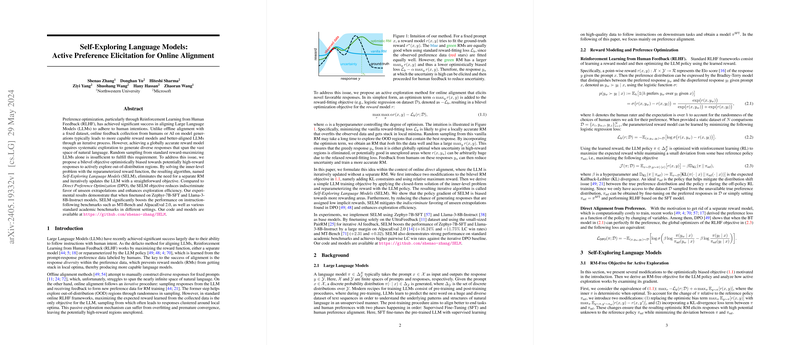An Expert Overview of the SELM Framework for Preference Optimization in LLMs
The paper under discussion introduces an advanced method for enhancing preference optimization in LLMs via a novel framework called Self-Exploring LLMs (SELM). This approach fundamentally focuses on integrating active exploration into the process of Reinforcement Learning from Human Feedback (RLHF), aiming to produce LLMs that are better aligned with human intentions and more effective in various instruction-following benchmarks.
Core Approach and Theoretical Foundations
The SELM framework is built on the premise that online feedback collection, rather than relying on a fixed dataset, tends to generate more capable reward models and improved alignment for LLMs. Traditional RLHF procedures are often bounded by local optima due to limited diversity in the response data. The SELM approach addresses this by integrating an optimism term into the reward fitting objective, thus encouraging the exploration of out-of-distribution (OOD) responses.
The paper introduces a bilevel optimization objective that incorporates an optimism term . This addition biases the reward model toward potentially high-reward responses that are previously unexplored, allowing for more effective and dynamic learning. The resultant algorithm, SELM, reparameterizes the reward function to eliminate the need for a separate reward model (RM), subsequently simplifying the objective.
Empirical Validation
Experimental analyses validate the efficacy of SELM across multiple benchmarks. The framework was implemented using Zephyr-7B-SFT and Llama-3-8B-Instruct models, and performance was significantly boosted in instruction-following tasks such as MT-Bench and AlpacaEval 2.0. Specifically, SELM outperforming the baseline iterative Direct Preference Optimization (DPO) by margins of +16.24% and +11.75% on AlpacaEval 2.0 and +2.31 and +0.32 on MT-Bench, respectively.
Additionally, SELM demonstrated robust performance across various academic benchmarks, achieving improvements even in zero-shot, few-shot, and Chain-of-Thought (CoT) settings. The enhancements were consistent across different iterations, emphasizing the robustness and reliability of the SELM methodology.
Implications and Future Directions
Theoretically, SELM presents a profound implication for the field of AI alignment. By actively exploring OOD regions, it mitigates the risk of models becoming overfitted to local optima and ensures a higher probability of discovering globally optimal responses. Practically, the integration of optimism in the RLHF process provides a more efficient pathway for fine-tuning LLMs, which is critical in tasks requiring high adaptability and precision.
The SELM framework also highlights the potential for integrating this optimism-based exploration with other contemporary online RLHF methodologies, suggesting that future research could explore the synergistic effects of combining SELM with other sophisticated alignment techniques.
Conclusion
In summary, the SELM framework introduces a novel and effective approach to preference optimization in LLMs. By leveraging active exploration through an optimism-biased objective, SELM significantly enhances the alignment and performance of LLMs across various benchmarks. This research paves the way for future developments in AI alignment, emphasizing the importance of dynamic, exploration-based strategies in preference optimization. The code and models associated with this paper are available at SELM GitHub repository, providing a valuable resource for further research and application in the field.
